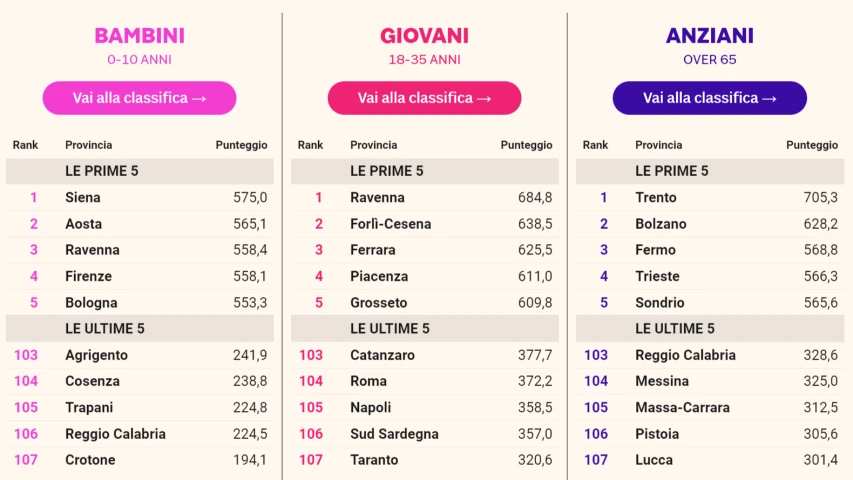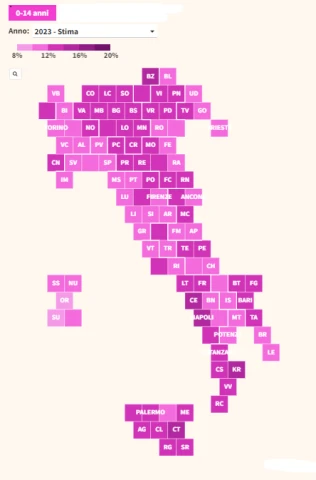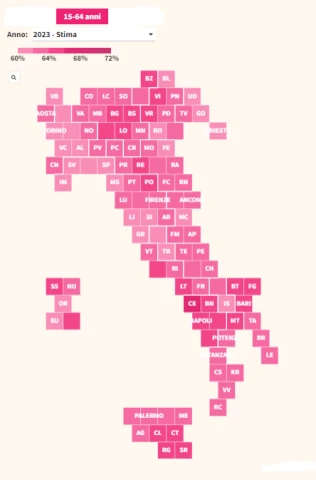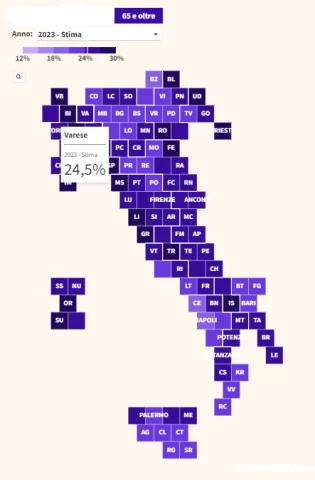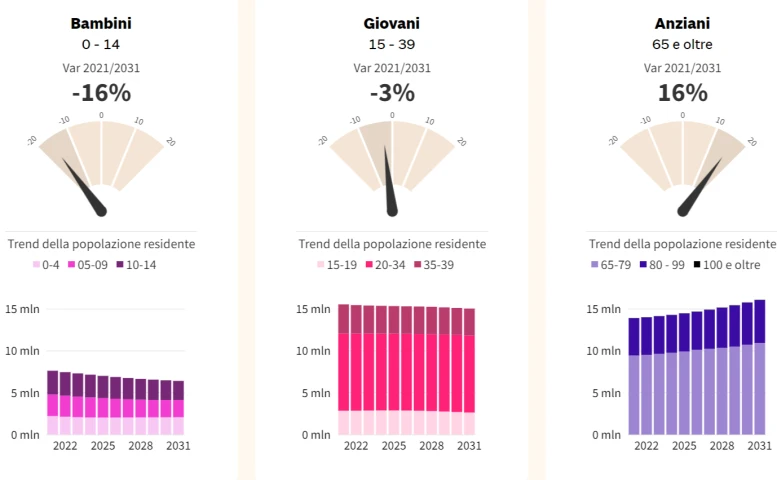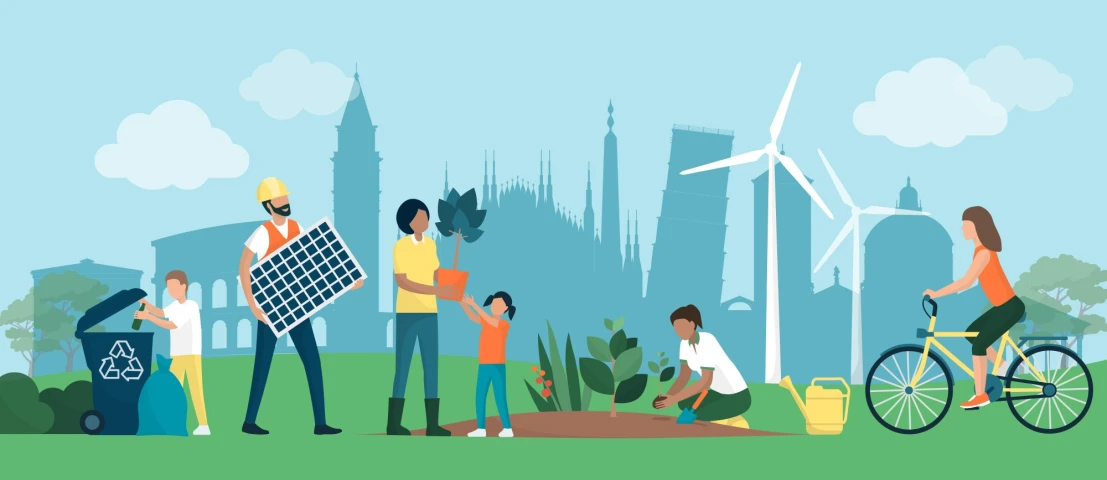Siena (Tuscany) comes in on the podium for number of active pediatricians per 1,000 residents under 15. Ravenna (Emilia Romagna) wins for cultural offerings, with 75.2 concerts put on for every 10 thousand residents under 35. Finally, Trento (Trentino Alto Adige) is first in life expectancy of the elderly, with an average of 21.6 years left to live at age 65 according to Istat's demographic indicators.
These are some of the firsts for which the three winning provinces in the Quality of Life in Italy survey declined for as many age groups: children, young people and the elderly.
The survey of well-being by age groups
The third edition of the three generational indices, each calculated on 12 statistical parameters provided by certified sources, was presented earlier this summer. The rankings, first published in June 2021, measure the "responses" of territories to the specific needs of the three most fragile and at the same time strategic generational targets, the services aimed at them, and their living and health conditions.
The geography of well-being
In addition to the winning provinces, territorial gaps are confirmed and some areas stand out across the board. For example, Romagna stands out on the podium in the ranking on the well-being of young people, who just recently we have seen in the forefront of cleaning up the territory. And in the index dedicated to children, where Ravenna nonetheless comes third, four provinces of Emilia Romagna meet in the top 20. For the elderly, on the other hand, Trentino Alto Adige stands out: Trento and Bolzano are in the lead, thanks to spending on certain social services, low drug use and life expectancy. The two autonomous provinces, historically frontrunners in quality of life, are also found in the upper parts of the other two rankings.
The last 20 positions of the three indexes, however, are populated by territories in southern Italy, with rare exceptions: five Tuscan provinces among the last for quality of life for the elderly (penalized, among other things, by record consumption of antidepressants and low spending on home care); Verbano Cusio Ossola (Piedmont) in 102nd place, again for the over-65s; Rome (Lazio) fourth-to-last in the index for the young.
Other large cities also surprise with their negative performance toward the under-35s. Among the last 30 ranked are nine metropolitan cities: among others Naples (Campania, 105th), Palermo (Sicily, 101st), Bari (Puglia, 88th), Turin (Piedmont, 83rd) and Milan (Lombardy, 79th). Unaffordable rents, against which even the latest university protest was ignited, weigh heavily: the incidence on the average declared income has grown by 16 percent in the last year.
Demographic map
Incidence of children (0-14 years), working-age population (15-64 years) and elderly (65 years and over) on the resident population (total residents=100), year by year.
The new indicators
Major changes in the provinces' rankings, compared with last year's edition, may result from changes in the panel of indicators: 26 out of 36 have been confirmed, ten are new entries. Each parameter was assigned a score for each province from 1000 to 0. And the final ranking is the result of the average of the scores achieved.
In the children's index, the one that has undergone the most changes, debut the average school lunch fee, up 2.14 percent last year, which weighs differently on the average declared income: from 1.6 percent in Rome (Lazio) to 7.2 percent in Trapani (Sicily), while in Agrigento (Sicily), the service just is not provided. Municipalities' per capita spending on social interventions and services for families and minors; numerical and literacy skills of eighth graders, worsened in all Italian provinces post-pandemic.
In the ranking of young people, however, enters-among others-the trend of residents between 18 and 35 years old, up only in 23 out of 107 provinces, and the index of satisfaction with one's job. Young people between the ages of 20 and 34 are most satisfied in the smaller provinces: no metropolitan city is in the top 20 positions in the ranking linked to this parameter. Sixteen of the bottom 20 provinces, on the other hand, are southern, of which six are metropolitan cities: here "urban disadvantage" adds up to less development.
Finally, in order to measure the well-being of the elderly, in addition to beds in nursing homes, an index of "loneliness" has been introduced: the incidence of single-family households composed of single people over 65 hits a record in Aosta (Valle d'Aosta), followed by Milan (Lombardy) and Rome (Lazio).
Trends
The children. Central Italy and Friuli Venezia Giulia win more records
Three Tuscan and one Marche region in the top ten. Siena (Tuscany) - by virtue of a series of good placings - is the leader ahead of Aosta (Valle d'Aosta), and as far as Tuscany is concerned, it is accompanied in the top ten by Florence (fourth) and Arezzo, tenth, while Ancona (Marche) is in ninth position.
Central Italy comes out on top in the quality of children's lives, even winning some stage records: Rome (Lazio) is first for the lower "weight" of school canteen fees, Macerata (Marche) for the absence of reported crimes against minors and Prato (Tuscany) for schools equipped with gymnasiums ahead of Puglia's Barletta Andria Trani and Lecce.
The South maintains the excellences of Cagliari (Sardinia), linked to the presence of pediatricians with Siena (Tuscany) second, and Nuoro (Sardinia) for very large living spaces, but generally loses positions: it is precisely Cagliari, 31st, the first of a South that finds itself occupying the last 24 steps. The tail-end is Crotone (Calabria), which - among other things - is last in the two new parameters on the "skills" demonstrated by eighth-graders based on Invalsi tests. Where, on the contrary, Belluno (Veneto) stands out, with a first and a second place.
With respect to the "indices" concerning young and old, on the children's side, good performances emerge from several metropolitan areas: the aforementioned Florence (Tuscany) is tailed by Bologna (Emilia Romagna, fifth, and best of all for the use of kindergartens), while both Milan (Lombardy) and Rome (Lazio) - 20th and 24th, respectively - settle in the first quarter of the overall ranking. Lastly, the good performance of Friuli Venezia Giulia should be mentioned, with the four provinces distributed between Gorizia's sixth position, leading for equipped areas, and Trieste's 18th.
The Young. Verona has the lowest Neet rate
They have gotten a lot from their area, hit by the floods, and thousands have mobilized to reciprocate ready to lend a hand. These are the young people from the provinces of Ravenna and Forlì Cesena, first and second in a ranking that, like last year, sees a podium occupied entirely by Emilia Romagna, with Ferrara placing third.
Ravenna obtains ten times out of 12 a placement in the first half of the ranking, with podium results - among other things - in two of the four new parameters introduced: it is first - in proportion to the population between 18 and 35 years of age - for the supply of concerts and is second behind Gorizia (Friuli Venezia Giulia) for increase in young residents between 2019 and 2023 (an item that sees less than a quarter of the territories with a positive balance and ten southern areas that lose 10% or more boys and girls in four years).
In the other two rankings under the banner of novelty, Verona (Veneto) is the only province that remains below the 10 percent level for young people who do not study or work, the so-called Neet (at the opposite end is Caltanissetta in Sicily with 46 percent), while Cuneo (Piedmont) records the highest rate of satisfaction with their jobs: here we note the second place occupied by Enna (Sicily) and the black jersey assigned to Taranto (Puglia), which also ends up behind all in the overall ranking.
Among the last 24, Rome (Lazio, 104th) is the only area not in the South, penalized in particular by the huge incidence of rents: compared with an average annual income of 25,400 euros, the rent for a two-room apartment in a semi-central area comes to 1,620 euros per month.
The elderly. Less lonely people in the South, three Tuscans last
A success achieved by a very wide margin over the runner-up. It is that of Trento (Trentino Alto Adige), which is unrivaled when it comes to quality of life for the elderly, finishing in the top five rankings (out of 12), with as many as three absolute wins: for life expectancy (of 21.6 years for those over 65, with Naples in Campania and Siracusa in Siicilia last at 19), home care, and transportation for the elderly and disabled. Also podium ranking according to low drug use for chronic diseases (third).
In this last aspect, Bolzano does better than all, finishing second in the overall ranking, completing the triumph of Trentino Alto Adige. Of note, among others, is the third position of Fermo (Marche), four times present among the top ten, the fourth place of Trieste (Friuli Venezia Giulia) and the Lombard trio Sondrio-Cremona-Como in fifth, sixth and seventh place in a ranking that - among areas including large cities - "promotes" Bologna (Emilia Romagna), 30th, and Rome (Lazio), 32nd.
Asti (Piedmont) clearly dominates in the new indicator of beds in assisted-living residences (more than 61 per thousand over-65s), while the South takes the lead in four rankings: with Barletta Andria Trani (Apulia) for the lower proportion of elderly people living alone (another new parameter), with Oristano (Sardinia) for libraries, and with Foggia (Apulia) for both the percentage of nurses and the modest use of antidepressant drugs. In contrast, the very issues that emerge from this ranking contribute to assigning Tuscany with Massa Carrara, Pistoia and Lucca the last three positions in the overall index.




